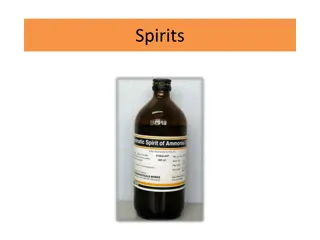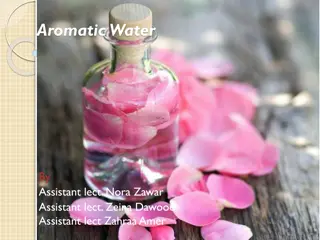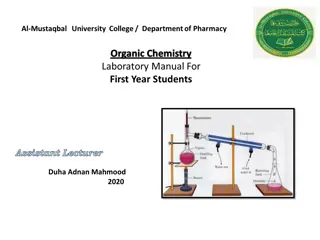SEPARATION COLUMNS
Azeotropic distillation plays a crucial role in the efficient recovery and recycle of organic solvents in the chemical industry. It addresses the challenges posed by azeotropes in separation processes, offering methods like pressure swing distillation and extractive distillation. Understanding the t
0 views • 9 slides
ASPEN Staged Separation Unit-Ops
Introduction to Aspen Staged Separation Unit Operations for the purification of desired components by removing impurities and pollutants using distillation, absorption, and stripping columns. This technology is relevant to ammonia synthesis to prevent catalyst poisoning by removing CO2 through absor
0 views • 26 slides
Understanding Spirits and Their Uses in Therapeutics and Flavoring
Spirits, also known as essences, are alcoholic or hydro-alcoholic solutions containing volatile substances. They can be classified based on therapeutic or flavoring purposes. These solutions are prepared by distillation or dissolving volatile substances in alcohol, with varying alcohol content. Spir
4 views • 17 slides
Intra-Distillation for Parameter Optimization
Explore the concept of parameter contribution in machine learning models and discuss the importance of balancing parameters for optimal performance. Introduce an intra-distillation method to train and utilize potentially redundant parameters effectively. A case study on knowledge distillation illust
8 views • 31 slides
Understanding the Basic Principles of Distillation
Distillation is a process used to separate components in a liquid mixture based on differences in vapor pressures. This involves techniques like simple, steam, and fractional distillation, as well as understanding binary mixtures, boiling points, vapor pressures, and vapor-liquid equilibria. Raoult'
5 views • 42 slides
Knowledge Distillation for Streaming ASR Encoder with Non-streaming Layer
The research introduces a novel knowledge distillation (KD) method for transitioning from non-streaming to streaming ASR encoders by incorporating auxiliary non-streaming layers and a special KD loss function. This approach enhances feature extraction, improves robustness to frame misalignment, and
0 views • 34 slides
Understanding Evaporation in the Food Industry
Evaporation, a key process in the food industry, involves removing excess water from raw materials or processed foods to enhance preservation and reduce costs. It requires considerations such as heat transfer, temperature control, and prevention of overheating. Evaporation differs from dehydration a
0 views • 22 slides
thermoelectric modules
Thermoelectric coolers are environmentally safer and find applications in portable air\/water refrigerators, electronic cooling, thermal management systems in medical devices, and water distillation. Their reliable, lightweight, and noiseless operation has gained significant consumer market attentio
1 views • 3 slides
Understanding Spirits: Types and Uses
Spirits are alcoholic or hydro-alcoholic solutions of volatile principles, mainly volatile oils, classified into therapeutic and flavoring types. They are prepared by distillation or dissolving volatile substances in alcohol, with varying alcohol content. Proper storage in light-resistant containers
1 views • 20 slides
Volatile Oils in Pharmacognosy and Phytochemistry: Composition, Chemistry, Uses
Volatile oils, also known as essential oils, are derived from terpenes and their oxygenated compounds. These oils possess characteristic odors and are extracted from plants through various methods like hydro-distillation and steam distillation. They are commonly used as flavoring agents, perfumes, a
0 views • 29 slides
Distillation Column Operations and Equilibrium Conditions
Explore various aspects of distillation column operations, including equilibrium and operating conditions, total condenser setups, feed stage mass/energy balances, McCabe-Thiele solutions, and limiting operating conditions. Learn about vapor/liquid efficiencies and the relationships between differen
2 views • 40 slides
Standard Unit equipment manufacturer & suppliers | Goel Scientific | Canada
Goel Scientific Glass offers a multi-purpose pilot plant Distillation unit that suits any application, Standard Unit equipment, The perfect compromise between quality & price, supply Canada, USA Ontario, Quebec, BC Alberta
1 views • 11 slides
Distillation Process and Applications in Food Industry
Distillation is a separation process used in the food industry to separate components in a mixture based on their volatility. It involves vaporization, condensation, and re-evaporation to achieve separation. Steam distillation is a method where steam is used to reduce boiling temperatures for safe s
1 views • 13 slides
Distillation Process for Purifying Water
Distillation is a method used to purify water by separating it from impurities through evaporation and condensation. It involves heating the water until it evaporates, then cooling the vapor to collect the purified water. This process ensures the removal of harmful substances and microbes, resulting
1 views • 11 slides
Overview of Tannins: Composition, Chemistry, and Reactions
Tannins are complex organic substances found in various plant sources known for their astringent properties. They have therapeutic uses in medicines and commercial applications in industries like leather. Tannins form colloidal solutions, exhibit specific chemical reactions, and are classified into
2 views • 25 slides
Distillation: A Method for Separating Volatile Substances
Distillation is a method used in pharmacy to extract active principles, separate substances, and recover solvents. Simple distillation involves vaporizing a liquid, condensing the vapors, and collecting the liquid. It is commonly used for separating liquids from non-volatile solids under atmospheric
1 views • 69 slides
Understanding Naphthalene: Properties and Production
Naphthalene, derived from coal tar or petroleum, is a key compound used in various industries. Its isolation process involves distillation and purification steps to obtain high-purity naphthalene. With its distinct chemical and physical properties, naphthalene plays a significant role in industrial
2 views • 10 slides
Isolation and Analysis of Terpenoids: Menthol, Citral, Artemisin
Menthol, Citral, and Artemisin are important terpenoids commonly found in plants like Mentha species. The isolation methods involve hydro-distillation and steam distillation, resulting in the extraction of these valuable compounds for various pharmaceutical applications.
0 views • 21 slides
Industrial Production of Acetone and Butanol from Corn
Industrial production of acetone and butanol from corn involves a process reported by Beesch in 1953, which includes steps like using specific Clostridium species for fermentation, inoculum preparation, and recovery through distillation. The method has been essential for producing acetone and butano
0 views • 15 slides
Network Compression Techniques: Overview and Practical Issues
Various network compression techniques such as network pruning, knowledge distillation, and parameter quantization are discussed in this content. The importance of pruning redundant weights and neurons in over-parameterized networks is highlighted. Practical issues like weight pruning and neuron pru
0 views • 37 slides
Separating Components of Ternary Mixtures: Experiment and Methods
Experiment aims to separate sand, sodium chloride, and calcium carbonate in a mixture to calculate percentages and recovery. Explore various methods like chromatography, distillation, extraction, centrifugation, crystallization, and sublimation for component separation.
1 views • 30 slides
Understanding Petroleum Fraction Distillation Curves
Characterization and properties of petroleum fractions are essential for understanding their behavior, particularly through distillation curves. These curves depict the boiling points of crude oil or petroleum fractions, highlighting components' volatility ranges. Various methods like ASTM D86, True
0 views • 28 slides
Overview of Distillation: Methods and Applications
Distillation is a crucial process for purifying liquid organic compounds by converting them to vapor and then back to liquid through condensation. This process is vital for various applications, including the separation of different liquids based on their boiling points. Distillation methods such as
0 views • 10 slides
Distillation in Practice: Making Ribena
Explore the process of making Ribena, a popular blackcurrant drink, through the lens of distillation. Learn how distillation is used to separate blackcurrant juice from skins, remove water, and collect aroma particles to create the final beverage. Engage with key concepts of distillation and filtrat
7 views • 4 slides
Understanding Separation Columns in Chemical Engineering
Explore the world of separation columns including distillation, absorption, and extraction, along with empirical correlations, minimum number of stages, Fenske equation, Underwood equation, Kirkbride equation, examples, and solutions presented by Dr. Kh. Nasrifar from the Department of Chemical and
5 views • 15 slides
Comprehensive Guide to Distillation: Types, Applications, and Advantages
Distillation is a widely-used method for separating mixtures based on differences in boiling points. This comprehensive guide covers the introduction, types of distillation, applications, advantages, disadvantages, and concluding remarks. Learn about simple distillation, fractional distillation, ste
0 views • 18 slides
Preparation Methods and Uses of Aromatic Water in Pharmacy
Aromatic water is a liquid pharmaceutical preparation containing volatile oils or essential oils. It is used as a pleasant medium for administering water-soluble drugs. Various preparation methods include distillation, solution, alternate solution, and dilution methods. Distillation method is used f
2 views • 17 slides
Understanding Distillation: Methods and Factors Affecting Boiling Points
Distillation is a process used to separate liquids based on their boiling points, with methods like simple, fractional, vacuum, and steam distillation. The boiling point of a compound is influenced by factors such as molecular weight and functional groups, where higher weights and polar groups lead
1 views • 15 slides
Understanding Distillation: Boiling Points and Factors
Distillation is a process of vaporizing and condensing liquids to separate components based on boiling points. This method utilizes differences in boiling points of liquid mixtures to achieve separation. Factors influencing boiling points include molecular weight, functional groups, and intermolecul
0 views • 16 slides
Distillation as a Defense Against Adversarial Perturbations in Deep Neural Networks
Deep Learning has shown great performance in various machine learning tasks, especially classification. However, adversarial samples can manipulate neural networks into misclassifying inputs, posing serious risks such as autonomous vehicle accidents. Distillation, a training technique, is proposed a
3 views • 31 slides
Effective Data Augmentation with Projection for Distillation
Data augmentation plays a crucial role in knowledge distillation processes, enhancing model performance by generating diverse training data. Techniques such as token replacement, representation interpolation, and rich semantics are explored in the context of improving image classifier performance. T
0 views • 13 slides
Organic Chemistry II Lecturer Raghad Aldoghachi - Laboratory Safety Rules and Distillation Techniques
Explore the world of organic chemistry with Lecturer Raghad Aldoghachi through laboratory safety rules emphasizing following instructions, chemical safety, and appropriate attire. Learn about hazard symbols, organic compound studies, distillation as a separation method, purification of liquid organi
0 views • 17 slides
Distillation Safety Scenario: Handling a Cracked Round Bottom Flask
In this distillation safety scenario, you face a cracked round bottom flask leaking amine. Immediate actions involve unplugging the heat source, containing the material, turning on emergency exhaust, and alerting others to evacuate. Preventative measures such as checking for cracks, proper stirring,
0 views • 4 slides
Understanding Crude Oil and Fractional Distillation Process
Crude oil is a mixture of various chemicals formed from the decomposition of microscopic plants and animals. Through fractional distillation, the fractions in crude oil are separated based on boiling points to obtain products like petrol, diesel, and lubricating oil. The process involves heating the
0 views • 15 slides
Understanding Distillation: A Comprehensive Overview
Distillation is a crucial separation technique used in chemistry to purify materials by separating liquids with different boiling points. This process involves simple and fractional distillation methods, each with specific steps and applications. The article discusses the importance, advantages, and
0 views • 13 slides
Chemical Engineering Processes at University of Diyala
The Chemical Engineering Department at the University of Diyala covers various processes in the chemical industry, including hydrogenation, energy consumption, butylene production sources, classical methods like absorption and distillation, as well as butadiene extraction. The application of these p
0 views • 18 slides
Study of Distillation Characteristics of Kerosene and Petroleum Solvents
This research proposal aims to investigate the distillation characteristics of Kerosene (IS 1459) and Petroleum Hydrocarbon Solvents (IS 1745) to differentiate between them. With overlapping boiling points, it is crucial to determine the 50% and 95% volume recovery temperatures in both standards to
0 views • 11 slides
Analytical Strategies for Identifying Off-Note in Fragrances
In fragrance production, detecting off-notes is crucial. This case study explores issues with menthone distillation, suggesting strategies like preparative gas chromatography and GC-sniffing technique. Correct identification leads to enhanced fragrance quality.
0 views • 20 slides
Understanding Azeotropic Distillation Sequences in Chemical Engineering
Azeotropic distillation columns play a crucial role in separating complex mixtures containing azeotropes like alcohols, ketones, ethers, acids, and water. By studying phase diagrams, residue and distillation curves, and process flow diagrams, engineers can grasp the nuances of product composition co
0 views • 22 slides
Understanding Distillation in Chemistry: Purification and Separation Methods
Distillation is a crucial process in chemistry for purifying organic compounds by selective evaporation and condensation. It involves the separation of substances based on their boiling points, resulting in either nearly pure components or increased concentrations of specific compounds in a mixture.
0 views • 14 slides







































